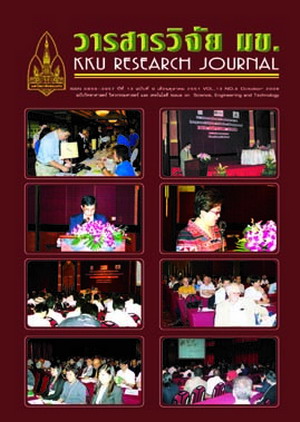Earthworm: potential bioindicator for monitoring diffuse pollution by agrochemical residues in Thailand
Main Article Content
Abstract
The use of pesticides has long been a feature of conventional agricultural practice and their use has made it possible to increase crop yields and food production. However, the impact of many of these chemicals on ecosystem and human health has been of concern due to widespread impacts beyond crop protection. Economical monitoring procedure for assessing agrochemical non-point source pollution is needed. Earthworms are important components in agro- ecosystem. They play a significant role in soil functioning and soil fertility. The purpose of this investigation was to assess the potential of earthworm as bioindicator of agrochemical residues in soil. The survey of earthworm population was conducted in the different land used management in Khon Kaen Province, Thailand during year 2006-2007. The physical soil properties (bulk density, moisture and porosity) and the chemical soil properties (pH, EC, organic matter, CEC, Total nitrogen, available phosphorus, Exchangeable K, Na, Mg and Ca) and pesticide residues were analyzed to correlate the results with the biological parameters. Ecotoxicological study of pesticide to earthworm has confirmed the results in the field. The results showed that the earthworm cast of Pheretima sp. per square meter in different land uses was significantly different (p<0.05) from each site and the earthworm casts in land used without using pesticide were higher than land use with using pesticide. The earthworm population was positively correlated with habitat suitability but negatively correlated with the degree of agrochemical residues in soil.
Article Details
How to Cite
Iwai, C. B., Pratad, Y., Sereepong, S., & Noller, B. (2017). Earthworm: potential bioindicator for monitoring diffuse pollution by agrochemical residues in Thailand. Asia-Pacific Journal of Science and Technology, 13(9), 1081–1088. retrieved from https://so01.tci-thaijo.org/index.php/APST/article/view/83543
Section
Research Articles


